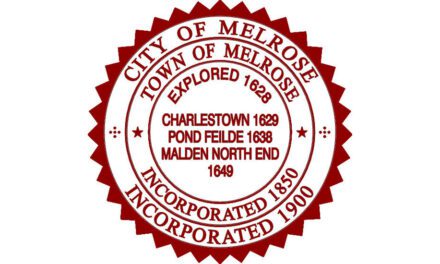By BOB BURGESS
MELROSE — Supt. of Schools Cyndy Taymore on Tuesday presented her educational budget proposal for next year, a $27,065,941 spending plan that brings the city a little closer to meeting the challenges it faces.
Taymore’s budget proposal, like any other education budget in any other year, is subject to change.
On March 3, the School Committee will review revenue and revolving accounts, the Early Childhood Center, and allocations for the central office, among other things. On March 10, there will be a public information session on the budget package. On March 17, the school board will continue its review, going over elementary school programs (including music fees), a review of special education, English as a Second Language and Title I. On March 31 the middle school and high school programs will be reviewed, as well as Curriculum and Instruction and Professional Development plans.
On April 28, there will be a public forum on the School Department budget, with a vote on the final budget and any proposed fees set for that night.
At some point in the spring, the aldermen will vote on the school budget too.
The fiscal year 2016 school budget proposal represents an 11 percent increase over current spending, but education advocates in the city — including Mayor and School Committeeman Robert J. Dolan — feel it’s time to put more money into learning.
In a Tuesday morning address to the Chamber of Commerce, for example, Dolan said the city needs to have a “mature discussion” about public education. “We’ll have to come up with more money for our schools if we are going to compete with the likes of Reading, Arlington and Andover,” Dolan said. “Parents (in Melrose) who send their kids to our schools from kindergarten through the eighth grade shouldn’t have to spend $15,000 to $20,000 (a year) to send their kids to (private) high school,” meaning Melrose High should set a standard for public school excellence.
Taymore, in a strong introduction to next year’s budget plan, said, “For three years, we have been focused on aligning curriculum both horizontally and vertically to improve the depth and consistency of content and instruction across schools and courses, as well as to increase rigor; widen our educators’ repertoire of best practices so that they may support all learners in accessing a standards based curriculum; and develop assessments that provide us with data to gauge our progress in these areas. The progress we have made has been achieved within our limited financial resources and by staff and administrators who have been extraordinarily hardworking and creative. However, we have reached a point in our work that, in order to progress to the next level of growth and achievement, we need to add additional resources both to meet the instructional needs of our students and to support our staff in their work. It is imperative that we continue to focuson improving teaching and learning so that we may deepen our educators’ knowledge and skill and continuously advance high expectations for student growth and achievement for all our children. Our overarching goal is that all students can be successful in an increasingly competitive and global economy. Thus, the guiding question for FY16 is “What additional resources do we need as a district so that we can continue to grow and achieve the highly effective school district our students deserve and we desire?”
“We have focused on improving and increasing our capacity in planning, curriculum and content, instruction, and assessment and data so that we may develop a school system that is constantly improving teaching and learning, and constantly raising achievement outcomes for all students. However, none of this is attained without adequate funding invested in people, programs, resources, and technology. Furthermore, in a society and economy marked by exponential growth in information, rapidly changing technology, and a globally connected world, the district needs to be flexible and adaptable to frequent changes and demands. In order to grow and sustain the school system we desire, we need to engage in an open, frank conversation about school financing and the needs of the district.
“As stated above, we have been able to make a number of advancements due to reorganization of departments and programs, reallocations with the school budget, raising fees, and some additional funding. Parent Teacher Organizations, the Melrose Education Foundation, private foundations and organizations have helped to fund technology, professional development, and curriculum materials. In addition, the city bonded $480,000 for curriculum materials, and provided funds to expand varsity lacrosse and launch girls’ hockey, for upgrades to the accounting system, and for technology training. As a result, we have been able to do the following:
Reorganize and reallocate funding for the following positions:
• An additional 1.0 psychologist for the secondary campus
• 3.0 English as a Second Language teachers
• 2.6 elementary Academic Interventionists
• The Director of Visual and Performing Arts
• 2.0 Elementary Instructional Coaches.
• 1.0 Academic Facilitator divided between the high school and middle school.
Add the following positions:
• 1.0 fourth grade teacher at the Lincoln School
• .4 math teacher at Melrose High School
• Develop a strong, purposeful internal system of horizontal and vertical professional development to provide staff with training in content, instruction, and assessment.
• Align our curriculum with the 2011 Massachusetts Frameworks in English Language Arts and Math.
• Implement new standards and expectations for reading, writing, and math across the district.
• Develop curriculum maps, identify best instructional practices, and write common assessments for all content areas.
• Renegotiate the teachers’ contract to be more financially competitive and raise professional expectations.
• Implement the state’s new Educator Evaluation System.
• Add more offerings at the high school to support student interests, expand opportunities, and enable 100% of our students to meet the new Mass Core graduation requirements.
• Pilot E-readers and Chrome books at several schools.
• Add girls’ hockey, expand boys’ and girls’ lacrosse, and expand the number of musical and drama performances at the middle school.
• Develop a tiered system of support in order to provide intervention and extension for students K-5.
• Pilot a general education/special education alternative program at the middle school.
• Develop a system wide approach for student support teams to identify struggling students and to provide research based interventions and supports.
• Implement an English Language Learners program at four schools.
• Support educators to become either SEI (Sheltered English Immersion) endorsed or certified as an English as a Second Language teacher, in accordance with new state regulations.
• Purchase new print and digital materials in math, science, global languages, social studies, and English Language Arts.
• Shift responsibility for the buildings and custodians to the Department of Public Works.
• Establish a Special Education Stabilization Fund in the city budget as a contingency fund for unexpected special education costs.
“As we undertake the budget process for FY 16, we have a choice to make. A ‘status quo plus’ budget for FY16 would enable us to maintain our current level of service plus four positions necessary for next year: an elementary teacher for Winthrop, an elementary teacher for Lincoln, one ESL teacher for the elementary level, and an academic interventionist at the Horace Mann. In a ‘growth’ budget, we include the positions needed for 2015-16 and add a number of positions and resources that we believe are instrumental to achieving our vision and goals for the Melrose Public Schools. These resources are divided into the following categories: Direct Instruction and Support to Students; Instructional Support for Staff; Curriculum Resources; Professional Development; Technology and Digital Resources; and the Structural Deficit. We do not view this list as either exhaustive or excessive. Nor can we predict any new mandates that may come from either the state or federal level. We believe this budget proposal will enable us to advance instruction and student outcomes and give us the resources we need to support those efforts. Our overarching goal is to provide our students with the knowledge and skills necessary for college and career readiness. College and career readiness skills extend beyond content knowledge and include, but are not limited to, collaboration and team work, critical thinking and problem solving, creativity and imagination, oral and written presentation, research skills, multiple literacies such as technology, finance, media, civic, and information, and global and cultural awareness. Our children will need these skills so that they become adaptable lifelong learners who can navigate the rapid shifts in employment, society, and culture they will encounter in the future,” Taymore wrote.




